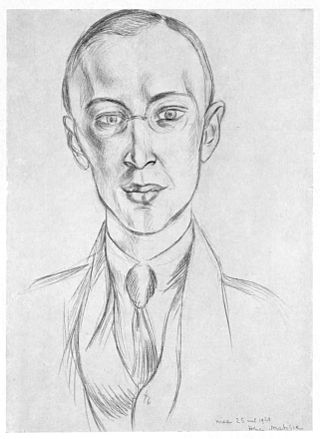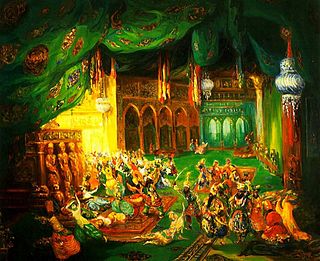Related Research Articles
The Piano Quintet in F minor, Op. 34, by Johannes Brahms was completed during the summer of 1864 and published in 1865. It was dedicated to Her Royal Highness Princess Anna of Hesse. As with most piano quintets composed after Robert Schumann's Piano Quintet (1842), it is written for piano and string quartet.

Hugo Emil Alfvén was a Swedish composer, conductor, violinist, and painter. Alfvén was one of Sweden's principal composers. His "Swedish Rhapsody”, written when he was 31, is still one of the best-known pieces of Swedish music. After extensive European travels to develop his musical skills, Alfvén taught composition, before conducting choirs and orchestras. In 1954 he made the first Swedish classical stereo recordings. Hugo Alfvén’s extensive musical archive is held at Uppsala University, where he was music director for twenty nine years.

Sergei Prokofiev wrote his Symphony No. 3 in C minor, Op. 44, in 1928.

Sergei Prokofiev's Symphony No. 4 is actually two works, both using material created for The Prodigal Son ballet. The first, Op. 47, was completed in 1930 and premiered that November; it lasts about 22 minutes. The second, Op. 112, is too different to be termed a "revision"; made in 1947, it is about 37 minutes long, differs stylistically from the earlier work, reflecting a new context, and differs formally as well in its grander instrumentation.

The Symphony No. 1 in D major, Op. 25, also known as the Classical, was Sergei Prokofiev's first numbered symphony. He began to compose it in 1916 and completed it on September 10, 1917. It was composed as a modern reinterpretation of the classical style of Joseph Haydn and Wolfgang Amadeus Mozart. The symphony's nickname was bestowed upon it by the composer. It premiered on April 18, 1918, in Petrograd, conducted by Prokofiev. It has remained one of his most popular works.
Sergei Prokofiev began his Violin Concerto No. 1 in D major, Op. 19, as a concertino in 1915 but soon abandoned it to work on his opera The Gambler. He returned to the concerto in the summer of 1917. It was premiered on October 18, 1923 at the Paris Opera with Marcel Darrieux playing the violin part and the Paris Opera Orchestra conducted by Serge Koussevitzky. Igor Stravinsky made his debut as conductor at the same concert, conducting the first performance of his own Octet for Wind Instruments.
The two Serenades, Op. 11 and 16, represent early efforts by Johannes Brahms to write orchestral music. They both date from after the 1856 death of Robert Schumann when Brahms was residing in Detmold and had access to an orchestra.

Scheherazade, also commonly Sheherazade, Op. 35, is a symphonic suite composed by Nikolai Rimsky-Korsakov in 1888 and based on One Thousand and One Nights.

Masques et bergamasques, Op. 112, is an orchestral suite by Gabriel Fauré. It was arranged by the composer from incidental music he provided for a theatrical entertainment commissioned for Albert I, Prince of Monaco in 1919. The original score contained eight numbers, including two songs for tenor, and a choral passage. These numbers were not included in the published suite, which has four movements.
Sergei Prokofiev's String Quartet No. 1 in B minor, Op. 50 (1931) was commissioned by the Library of Congress. The Quartet was first performed in Washington, D.C., on 25 April 1931 by the Brosa Quartet and in Moscow on 9 October 1931 by the Roth Quartet. The string quartet is in three movements, lasting around 20–25 minutes.
Sergei Prokofiev's Quintet in G minor, Op. 39 is a piece of chamber music for oboe, clarinet, violin, viola and double bass, written in 1924. The quintet, closely related to Prokofiev's ballet, Trapèze, contains six movements and lasts 20–25 minutes.
The Quintet in A minor for Piano and String Quartet, Op. 84 is a chamber work by Edward Elgar.
Orchestral Suite No. 1 in D minor is an orchestral suite, Op. 43, written by Pyotr Ilyich Tchaikovsky in 1878 and 1879. It was premiered on December 20, 1879 at a Russian Musical Society concert in Moscow, conducted by Nikolai Rubinstein. The piece is dedicated to Tchaikovsky's patroness, Nadezhda von Meck.

The Piano Quartet No. 1 in G minor, Op. 25, was composed by Johannes Brahms between 1856 and 1861. It was premiered in 1861 in Hamburg, with Clara Schumann at the piano. It was also played in Vienna on 16 November 1862, with Brahms himself at the piano supported by members of the Hellmesberger Quartet. Like most piano quartets, it is scored for piano, violin, viola, and cello.
Sergei Prokofiev's Piano Sonata No. 4 in C minor, Op. 29, subtitled D’après des vieux cahiers, or After Old Notebooks, was composed in 1917 and premiered on April 17 the next year by the composer himself in Petrograd. The work was dedicated to Prokofiev's late friend Maximilian Schmidthof, whose suicide in 1913 had shocked and saddened the composer.
Ruralia hungarica is a name given by the Hungarian composer Ernő Dohnányi to four interrelated works.
Trapèze is a ballet by Sergei Prokofiev. Closely related to his Quintet, Op. 39 (1924), it contains eight movements and lasts 20–25 minutes. The complete ballet in eight movements was first performed in Gotha, a German town near Hanover, on 6 November 1925.

The Shylock Suite, Op. 57 is a six-movement work by Gabriel Fauré, first performed in 1890. In addition to four purely orchestral movements it includes two serenades for solo tenor with orchestral accompaniment. The composer constructed the suite from incidental music he had written the previous year for Edmond Haraucourt's play Shylock, an adaptation of Shakespeare's The Merchant of Venice, presented at the Théâtre de l'Odéon in Paris. The theatre music had been written for a small orchestra, and Fauré greatly expanded the orchestration for the concert suite.
References
- Booklet for CD, Noël Goodwin, Prokofiev: The Prodigal Son Op.46, Chandos, CHAN 8728